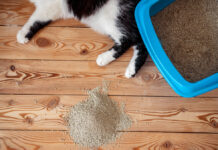If you’ve ever wondered “is ceramic safe for cats,” you’re not alone Many pet parents are concerned about choosing the right feeding materials for their furry friends Let’s dive into everything you need to know about ceramic bowls and cat safety.
The Safety of Ceramic Bowls for Cats: Quick Answer
Yes ceramic is safe for cats when properly maintained and chosen carefully. High-quality food-grade ceramic dishes can be an excellent choice for your feline friend’s dining experience.
Understanding Ceramic Materials and Pet Safety
Ceramics are made from clay and other natural materials, fired at high temperatures to create durable dishware. When considering pet supplies, it’s important to make thorough research, which you can find more about in our dog care section that covers various pet safety topics.
Benefits of Using Ceramic Bowls
- Durability: Quality ceramic bowls can last for years
- Weight: Heavy enough to prevent tipping
- Temperature Control: Keeps water cooler longer
- Easy Cleaning: Dishwasher safe
- Aesthetic Appeal: Various designs available
Potential Risks and Considerations
1. Quality Matters
Not all ceramic bowls are created equal, Low-quality ceramics might – Contain harmful chemicals- Chip easily- Harbor bacteria in cracks
2. Maintenance Requirements
- Regular inspection for chips
- Proper cleaning
- Replacement when damaged
How to Choose Safe Ceramic Bowls
When selecting ceramic bowls for your kitty, consider:
-
Food-Grade Certification
- Look for pet-specific products
- Check for safety certifications
-
Glazing Quality
- Ensure lead-free glazing
- Avoid metallic finishes
-
Design Features
- Smooth surfaces
- Non-slip bottom
- Appropriate size
Pet like boss offers comprehensive guides on pet care and safety, including detailed information about choosing the right feeding equipment for your furry friends.
Proper Care and Maintenance
To ensure your ceramic bowls remain safe for cats:
-
Daily Cleaning
- Wash with hot, soapy water
- Rinse thoroughly
- Dry completely
-
Regular Inspection
- Check for chips weekly
- Look for crazing (fine cracks)
- Monitor for wear
-
Replacement Schedule
- Replace damaged bowls immediately
- Consider annual replacement
- Keep spare bowls handy
Alternative Bowl Materials
While ceramic is safe for cats, other options include:
-
Stainless Steel
- Most durable
- Virtually unbreakable
- Easy to clean
-
Glass
- Non-porous
- Dishwasher safe
- Shows dirt easily
-
Bamboo
- Eco-friendly
- Lightweight
- Biodegradable
Expert Tips for Using Ceramic Bowls
-
Placement
- Set on non-slip surfaces
- Away from high-traffic areas
- Separate from litter boxes
-
Cleaning Schedule
- Wash daily
- Sanitize weekly
- Deep clean monthly
-
Safety Checks
- Morning inspection
- Evening inspection
- Weekly thorough check
Common Mistakes to Avoid
-
Using Damaged Bowls
- Chips can harbor bacteria
- Cracks may leak
- Sharp edges are dangerous
-
Improper Cleaning
- Using harsh chemicals
- Insufficient rinsing
- Incomplete drying
-
Poor Maintenance
- Ignoring wear signs
- Delayed replacement
- Inadequate cleaning
Signs It’s Time to Replace Your Ceramic Bowl
Watch for:1. Visible chips2. Deep scratches3. Crazing patterns4. Discoloration5. Rough surfaces
Making the Switch to Ceramic
If transitioning to ceramic bowls:
-
Gradual Introduction
- Keep old bowl available
- Place new bowl nearby
- Observe cat’s preference
-
Monitoring
- Watch eating habits
- Check for comfort
- Note any concerns
Environmental Impact
Ceramic bowls offer environmental benefits:- Long-lasting- Recyclable- Less plastic waste
Cost Considerations
Investment factors:1. Initial cost higher2. Longer lifespan3. Replacement needs4. Cleaning supplies
Final Thoughts
Ceramic is indeed safe for cats when you choose high-quality products and maintain them properly. The key is selecting food-grade ceramics and regularly inspecting for damage. With proper care, ceramic bowls can provide a safe, hygienic, and aesthetically pleasing feeding solution for your feline friend.
FAQs About Ceramic Cat Bowls
How often should I replace ceramic cat bowls?
Replace immediately if damaged, otherwise annually for optimal safety.
Can I put ceramic bowls in the dishwasher?
Yes, most ceramic bowls are dishwasher-safe, but check manufacturer instructions.
What if my cat refuses to use ceramic bowls?
Try different sizes or shapes, or consider alternative materials.
How can I prevent bacterial growth?
Clean daily, dry thoroughly, and replace damaged bowls promptly.
Remember, your cat’s health and safety come first. When in doubt about your ceramic bowl’s condition, it’s better to replace it than risk your pet’s wellbeing. Happy feeding!












